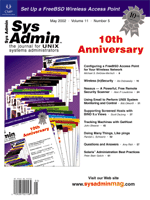
Article
Sidebar
What's 802.11b?02.11b is the IEEE standard for wireless communications in the 2.4-GHz band. It allows connections at up to 11 Mbps, and is practical in the short-to-medium range (local, to around 20 miles with the right antenna). Don't confuse it with the earlier generation 802.11 standard, which tops off at 2 Mbps, or its baby brother 802.11a, which operates at up to 56 Mbps in the 5-GHz band at a reduced range. Note also that 802.11g is due out some time in the future, and will offer 56 Mbps in the 2.4-GHz range, thus retaining backwards compatibility with 802.11b antennas. For now, however, 802.11b is the best choice for high-speed, medium-distance wireless connectivity. Wireless network connections can be used in many ways. Schools that can't afford to run CAT-5 to their classrooms might instead consider using well-placed access points (doubling as repeaters) and wireless cards in classroom computers. A coffee shop might offer high-speed wireless Internet access to its patrons. Businesses can run wireless networks to allow staff with laptops to be connected anywhere on their sites. Community-based wireless networks are also popular, offering wireless Internet access in metropolitan areas. Volunteers set up and maintain access points and antennas throughout their areas, and allow public access to the Internet. There are some inherent limitations to 802.11b, and they can range from un-noticeable to pretty major. Because 802.11b operates in the microwave band, anything that reflects microwaves is bad for transmission. Water is the worst -- and while that isn't usually a big problem indoors, it can adversely affect outdoor connections. Trees and plants are particularly bad -- wireless cards see them as a big body of impenetrable water. Save yourself a lot of trouble and plan your outdoor network in the spring, after the leaves are on the trees. Kitchen microwave ovens can also introduce interference into your connection, although it's not usually noticeable. Fortunately, these limitations are well known and are not too hard to work around, making 802.11b wireless networks fun and functional. |